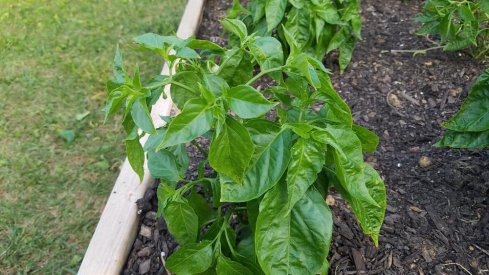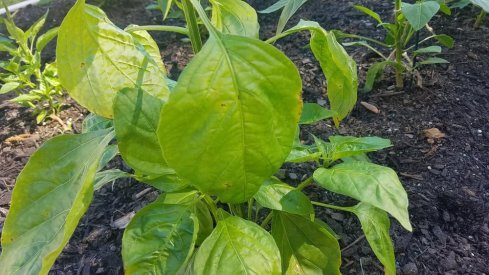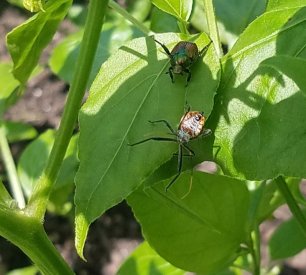-
Do you need help identifying a 🌶️?
Is your plant suffering from an unknown issue? 🤧
Then ask in Identification and Diagnosis. -
✅ Expert and friendly hot pepper grow advice.
✅ The latest information on hot pepper varieties.
✅ Reliable seed trading.
✅ Hot sauce recipes and food safety guidance.
✅ Hot sauce business tips for startups.
🌶️ And more!
It's all here, at The Hot Pepper! The Internet's original hot pepper community! Est. 2004.
You are using an out of date browser. It may not display this or other websites correctly.
You should upgrade or use an alternative browser.
You should upgrade or use an alternative browser.
Cal-Mag Question
- Thread starter p3nt4g0n
- Start date
podz said:Depends on the plant size. Maybe 1, maybe 100.
Most of the plants are between 1 ft and 2 ft tall.
solid7 said:Do you actually need the Cal-Mag - as in, are your plants deficient - or are you just adding it, because?
.
That could make a difference in the final answer.
Im hoping it will help. Alot of my plants are showing leaf curl / some wrinkling, with some having yellow splotching. Im assuming its some kind of deficiency. It could be the pH of my soil causing the issue. Its fresh soil, well they called it a soil mix. They said it was top soil, compost, and pine fines. This is my first time trying to grow so I didnt add anything to the soil.
Cal-Mag is light on nitrogen at 2-0-0, so as long as you don't exceed the recommended one teaspoon per gallon, you aren't going to harm anything. I've used it in past to clear up calcium deficiencies with good results. Just mix up a one gallon batch and water as you normally would. If you run out, make another one gallon batch.
To elaborate on my first sentence, if your plants aren't suffering from anything that Call-Mag will clear up, it won't make them any worse and if you already spent the money on it, you might as well use it.
In any event, post some pictures and some of us may be to able to help some more.
Good luck and welcome to the forum!
To elaborate on my first sentence, if your plants aren't suffering from anything that Call-Mag will clear up, it won't make them any worse and if you already spent the money on it, you might as well use it.
In any event, post some pictures and some of us may be to able to help some more.
Good luck and welcome to the forum!
dragon49 said:Cal-Mag is light on nitrogen at 2-0-0, so as long as you don't exceed the recommended one teaspoon per gallon, you aren't going to harm anything. I've used it in past to clear up calcium deficiencies with good results. Just mix up a one gallon batch and water as you normally would. If you run out, make another one gallon batch.
To elaborate on my first sentence, if your plants aren't suffering from anything that Call-Mag will clear up, it won't make them any worse and if you already spent the money on it, you might as well use it.
In any event, post some pictures and some of us may be to able to help some more.
Good luck and welcome to the forum!
I used a gallon on 20 plants, which is probably barely anything. I used the recommended amount per gallon. Here are some pics:
Attachments
That's not looking like calcium deficiency. Some of those leaves look paper thin, like they've just been transplanted outside. How long since you put them out, and where were they before? Also, sometimes, when a plant hasn't adapted to its new environment, or when there is excessive rainfall, nutrient uptake is disrupted, and this can mimic calcium, nitrogen, both, or other, deficiencies. (which it technically is, but not for lack of nutrients)
.
I don't like the Cal-Mag product. It's super expensive, and too often it gets recommended willy-nilly. You would be better off applying dolomitic lime to raised beds. Again, that's assuming that you actually have a deficiency, which I'm not convinced. Most soil and compost based mixes are far from calcium deficient. The directions for dolomitic lime are also much more straightforward...
.
Either way, be careful not to overdose calcium. I just read that it won't hurt to just lay down unnecessary calcium, but that isn't necessarily true. For a raised bed, I'd actually try to get a soil sample. Especially if you have a local ag extension office. If in doubt, add organic matter, or use a fish fertilizer, like Alaska Fish.
.
I don't like the Cal-Mag product. It's super expensive, and too often it gets recommended willy-nilly. You would be better off applying dolomitic lime to raised beds. Again, that's assuming that you actually have a deficiency, which I'm not convinced. Most soil and compost based mixes are far from calcium deficient. The directions for dolomitic lime are also much more straightforward...
.
Either way, be careful not to overdose calcium. I just read that it won't hurt to just lay down unnecessary calcium, but that isn't necessarily true. For a raised bed, I'd actually try to get a soil sample. Especially if you have a local ag extension office. If in doubt, add organic matter, or use a fish fertilizer, like Alaska Fish.
solid7 said:That's not looking like calcium deficiency. Some of those leaves look paper thin, like they've just been transplanted outside. How long since you put them out, and where were they before? Also, sometimes, when a plant hasn't adapted to its new environment, or when there is excessive rainfall, nutrient uptake is disrupted, and this can mimic calcium, nitrogen, both, or other, deficiencies. (which it technically is, but not for lack of nutrients)
.
I don't like the Cal-Mag product. It's super expensive, and too often it gets recommended willy-nilly. You would be better off applying dolomitic lime to raised beds. Again, that's assuming that you actually have a deficiency, which I'm not convinced. Most soil and compost based mixes are far from calcium deficient. The directions for dolomitic lime are also much more straightforward...
.
Either way, be careful not to overdose calcium. I just read that it won't hurt to just lay down unnecessary calcium, but that isn't necessarily true. For a raised bed, I'd actually try to get a soil sample. Especially if you have a local ag extension office. If in doubt, add organic matter, or use a fish fertilizer, like Alaska Fish.
Well, those pictures are before we just got basically a months worth of rainfall in a couple of days. As you can see I didn't mulch my bed with anything, which may have contributed I believe to BLS in several of my plants in this particular bed. I have been using neem oil for pests and copper fungicide for the suspected BLS, about 7 days in between each treatment.. I attached a couple of pics that shows what I think is BLS. Most leaves start showing alot of small brown spot on the underside before showing on the top. I do notice my soil isn't the best at drainage. After heavy rains I see bunches of mushrooms and gnats. I do have Alaska Fish which I havent used yet, and my local office is only 2 min up the road.
Attachments
As I said before, rainfall - especially heavy rainfall - will disrupt normal nutrient service, and give the appearance of nutrient deficiencies.
.
You're going to have gnats and mushrooms in raised beds. (it's a good sign, actually - that means lots of organic matter) I really wouldn't worry about that too much. But the main reason that I always recommend the Alaska fish, is because we get those torrential downfalls here, and I'm well familiar with plants that look like your pics. You don't want to add anything that you could risk overdosing, but you'll want to get something in there fairly soon. Is your raised bed sitting on top of earth, or do you have a liner in the bottom of it?
.
You don't have BLS. You have some localized, possibly fungal damage.
.
You're going to have gnats and mushrooms in raised beds. (it's a good sign, actually - that means lots of organic matter) I really wouldn't worry about that too much. But the main reason that I always recommend the Alaska fish, is because we get those torrential downfalls here, and I'm well familiar with plants that look like your pics. You don't want to add anything that you could risk overdosing, but you'll want to get something in there fairly soon. Is your raised bed sitting on top of earth, or do you have a liner in the bottom of it?
.
You don't have BLS. You have some localized, possibly fungal damage.
For best drainage in raised beds, it's best to skip the landscape fabric. I get that some people don't want anything tunneling up through the bottom, and that's understandable. If your mix is heavy, that could be reduce drainage, depending on the type of fabric you used. Small particles can clog it up, and turn in into more of a barrier. If you experience poor drainage, you may want to dig down and cut some holes in the cloth, and open it up to earth.
.
I see that you are in NC. If you're in an area with high clay soil, this could also be restricting drainage.
.
I see that you are in NC. If you're in an area with high clay soil, this could also be restricting drainage.
I added some alaskan fert. to all my plants. I used a gallon mix for 12 of my plants. I still have some type of pests or virus/fungal going on. It looks like we should have some dryer weather here. Also noticed small tiny brown dots on the undersides of some leaves on most of my pepper plants. Also what is the bug on the bottom pic?
Attachments
Top pest: Japanese beetle
Bottom pest: some type of squash bug
.
Neither of them are going to do your garden any favors.
.
EDIT: on second look at the bottom critter, it may be an assassin bug. The legs and antenna are what's making me second guess myself. Another angle, perhaps? Because if it's an assassin, that's a hugely beneficial insect.
Bottom pest: some type of squash bug
.
Neither of them are going to do your garden any favors.
.
EDIT: on second look at the bottom critter, it may be an assassin bug. The legs and antenna are what's making me second guess myself. Another angle, perhaps? Because if it's an assassin, that's a hugely beneficial insect.
Assasin bug it is, according to google image. Its tail points up.solid7 said:Top pest: Japanese beetle
Bottom pest: some type of squash bug
.
Neither of them are going to do your garden any favors.
.
EDIT: on second look at the bottom critter, it may be an assassin bug. The legs and antenna are what's making me second guess myself. Another angle, perhaps? Because if it's an assassin, that's a hugely beneficial insect.














